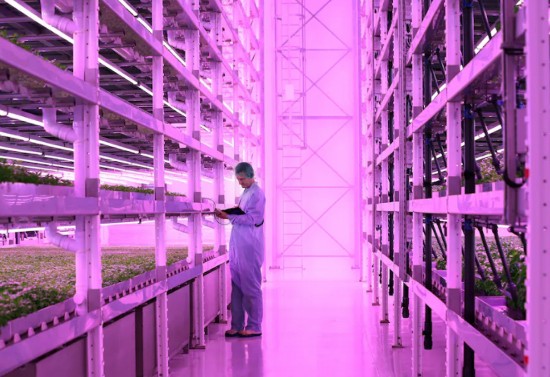The region of Kent in The United Kingdom is traditionally referred to as The Garden of England. The climate, soils, and abundance of farms, almost 10,000 in total, have made it a centre for fruit growing producing a third of England’s total. And now it appears that The Jones Food Company is making a new Garden of England operating the largest vertical farm in the country.
Established in 2017 by its founder James Lloyd-Jones, The Jones Food Company specializes in vertical farms using hydroponics. The company currently has built the largest vertical farm in North Lincolnshire, England, with 12 crop cycles of herbs and vegetables being grown year-round. And now it is adding a vertical farm that will be three times larger, about the size of 70 tennis courts, tended to by an army of robots.
The water being used in all its vertical farms is 100% recycled and supplemented by rainwater reserves. Hydroponics means smaller water requirements than traditional farming. And these vertical farms are low-carbon emitters. In fact, The Jones Food Company intends for its facilities to be carbon neutral in Lincolnshire by year-end, and in the Gloucestershire facility from the get-go. Solar panels on these warehouse facilities’ roofs supplemented by 100% renewable energy sources provide the power to light, heat, and operate the farms.
Why vertical farms now?
Back in 2014, I was asked to contribute a paper to an upcoming agricultural conference on urban farming. I wrote about Dickson Despommier, a professor at Columbia University, who conceived of the vertical farm. His notion was that with finite amounts of arable land and a world increasingly dominated by cities, the evolution of farming to move it closer to consumers necessitated their move into the urban fabric. The end result that Despommier envisioned was farming moving into buildings leaving more agricultural land freed up to return to a natural state as carbon sinks, and fewer emissions produced from the transporting of food from rural locales to urban consumers.
Despommier advocated for every city to produce 10% of its food needs locally and indoors. That would free up over 880,000 square kilometres (340,000 square miles) of farmland to be returned to its natural state which would be enough to reduce carbon dioxide (CO2) in Earth’s atmosphere to levels close to where they were in 1980.
The pros and cons of vertical farming were described by Kissairis Munoz in a Dr. Axe posting back in June of 2017. The pros included:
- Year-round crop production with higher yields.
- Fully weatherproofed.
- Less water-intensive.
- Less food waste.
- Less space needed for production.
The cons included:
- Not everything can grow this way. So far, vertical farms are good for leafy greens and tomatoes, not corn, wheat, and rice.
- Tend to be more energy-intensive using artificial light (a kilogram of food from a vertical farm requires about 1,200 kilowatts of electricity, whereas an outdoor farm gets sunlight for free).
- Higher labour and operational costs (The Jones Food Company may have an answer for the labour issue. Their newest vertical in Gloucestershire will only need 16 people who will supervise a team of robot helpers).









